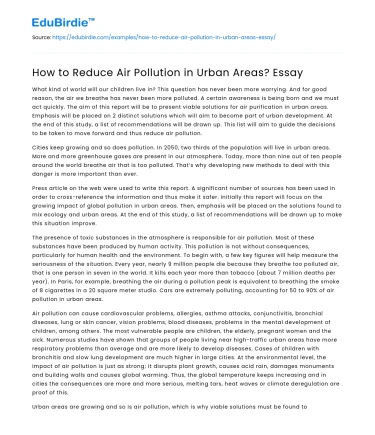What kind of world will our children live in? This question has never been more worrying. And for good reason, the air we breathe has never been more polluted. A certain awareness is being born and we must act quickly. The aim of this report will be to present viable solutions for air purification in urban areas. Emphasis will be placed on 2 distinct solutions which will aim to become part of urban development. At the end of this study, a list of recommendations will be drawn up. This list will aim to guide the decisions to be taken to move forward and thus reduce air pollution.
Cities keep growing and so does pollution. In 2050, two thirds of the population will live in urban areas. More and more greenhouse gases are present in our atmosphere. Today, more than nine out of ten people around the world breathe air that is too polluted. That’s why developing new methods to deal with this danger is more important than ever.
Save your time!
We can take care of your essay
- Proper editing and formatting
- Free revision, title page, and bibliography
- Flexible prices and money-back guarantee
Press article on the web were used to write this report. A significant number of sources has been used in order to cross-reference the information and thus make it safer. Initially this report will focus on the growing impact of global pollution in urban areas. Then, emphasis will be placed on the solutions found to mix ecology and urban areas. At the end of this study, a list of recommendations will be drawn up to make this situation improve.
The presence of toxic substances in the atmosphere is responsible for air pollution. Most of these substances have been produced by human activity. This pollution is not without consequences, particularly for human health and the environment. To begin with, a few key figures will help measure the seriousness of the situation. Every year, nearly 9 million people die because they breathe too polluted air, that is one person in seven in the world. It kills each year more than tobacco (about 7 million deaths per year). In Paris, for example, breathing the air during a pollution peak is equivalent to breathing the smoke of 8 cigarettes in a 20 square meter studio. Cars are extremely polluting, accounting for 50 to 90% of air pollution in urban areas.
Air pollution can cause cardiovascular problems, allergies, asthma attacks, conjunctivitis, bronchial diseases, lung or skin cancer, vision problems, blood diseases, problems in the mental development of children, among others. The most vulnerable people are children, the elderly, pregnant women and the sick. Numerous studies have shown that groups of people living near high-traffic urban areas have more respiratory problems than average and are more likely to develop diseases. Cases of children with bronchitis and slow lung development are much higher in large cities. At the environmental level, the impact of air pollution is just as strong; it disrupts plant growth, causes acid rain, damages monuments and building walls and causes global warming. Thus, the global temperature keeps increasing and in cities the consequences are more and more serious, melting tars, heat waves or climate deregulation are proof of this.
Urban areas are growing and so is air pollution, which is why viable solutions must be found to purify the atmosphere. Several methods can be used in urban areas. Green spaces are proving to be an excellent way to reduce pollution in cities. In this report, 2 solutions will be presented, one fundamental and the other very innovative.
Green spaces are proving to be an excellent way to reduce pollution in cities. Central Park in New York, Jardin de Valencia in Valence, Central Park in Sydney (see the picture) or La coulee verte in Nice, there are more and more of them in large cities and incorporating them harmoniously and effectively into the landscape is a real challenge. In addition to bringing leisure and harmony, these spaces have many advantages, especially in terms of the environment. These green spaces make it possible to maintain ecosystem services, by maintaining biodiversity and regulating the urban climate. They also provide pollution control, on the one hand by filtering the air to release more oxygen and on the other hand by reducing noise pollution. Finally, these areas allow the protection of many species, soil conservation and water quality control
Another innovative method has recently emerged, the CO2 absorber. The principle is simple, they are large filter panels installed at the entrance and inside cities. The polluted air is absorbate inside and filtered, and the purified air is released at the back. The polluting gases and micro particles are compressed and recovered in tanks that will be recycled. These absorbers are still under development and present a particularly ambitious project






 Stuck on your essay?
Stuck on your essay?

